Navigating the gardening world can be complex, but the plant’s soil pH chart simplifies this journey considerably. This chart becomes a steadfast guide, illuminating the soil pH requirements for plants, ensuring they flourish vibrantly.

Plants Soil pH Chart
Understanding Soil pH: A Comprehensive Guide for Gardeners
A pivotal factor that influences the health and growth of plants is the soil’s pH level, acting like a soil pH formula that determines the prosperity of your green companions. The best pH of soil for plants is neither too acidic nor too alkaline, ensuring the ideal pH of soil for plant growth. Delving deep into the plant’s soil pH chart, gardeners can uncover the precise soil pH levels for plants, ranging from vegetables and flowers to herbs, trees, and shrubs.
Each category, whether it be vegetables or herbs, has its unique soil pH requirements for plants, epitomized in distinct sections like the soil pH chart for vegetables or the soil pH chart for herbs. For instance, the soil pH requirements for vegetables resonate within an optimal pH range of soil, which is similarly echoed in the soil pH requirements for flowering plants, herbs, trees, and shrubs. Equipped with this knowledge, tweaking the soil to meet the specific needs of each plant category becomes an attainable goal, be it through methods to increase soil pH or other enhancing practices.
The Importance of Soil pH for Plant Growth and Health
The plant’s soil pH chart is not just a tool; it’s a gateway to understanding the subtle yet profound effects of soil pH on plants. The best pH of soil for plants varies, having unique influences on vegetables, flowers, herbs, trees, and shrubs. For example, the vegetable garden soil pH aligns with the specific needs of each vegetable variety, as detailed in the soil pH chart for vegetables.
Similar specificity is reflected in the soil pH chart for flowering plants, herbs, trees, and shrubs, each elucidating the optimal pH range of soil conducive to growth. Variations in soil pH levels for plants impact nutrient availability and overall health, signifying the importance of adhering to the soil pH requirements for plants.
Ensuring that the pH of soil for plants aligns with the ideal benchmarks, such as the soil pH requirements for herbs or the soil pH requirements for trees, is essential in promoting vibrant, healthy growth in your garden. Knowledge from the plant’s soil pH chart is a cornerstone, aiding gardeners in making informed decisions to nurture and optimize their gardens, respecting each plant’s unique soil pH formula and requirements.
How to Test Soil pH for Different Plants
Embarking on the testing journey requires an intimate understanding of the plant’s soil pH chart. This chart is a reservoir of knowledge, articulating plants’ nuanced soil pH requirements. Testing the soil involves discerning whether the environmental pH aligns with the soil pH formula necessary for the plants’ prosperity.
In case you missed it: Exploring the Essence of Korean Natural Farming (KNF): Harmony in Soil and Soul
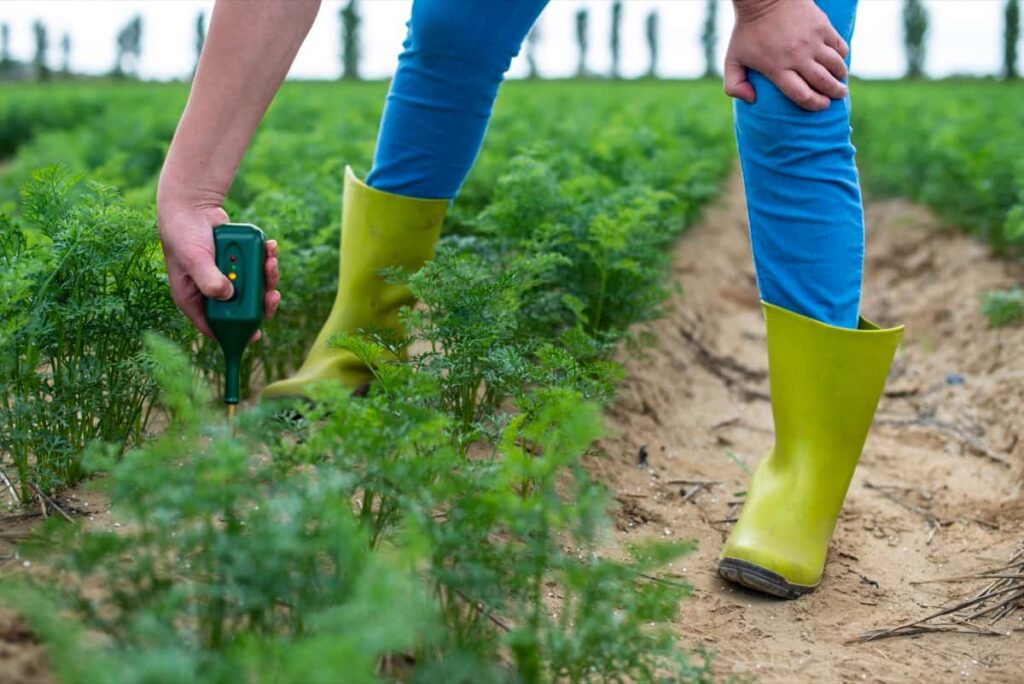
It’s imperative to comprehend the best pH of soil for plants, emphasizing the optimal pH range of soil. Essential tools in this endeavor include the soil pH chart for vegetables, herbs, trees, and shrubs, each offering specific guidelines, like the soil pH requirements for vegetables or the soil pH requirements for flowering plants.
For instance, utilizing the soil pH chart for herbs allows a deeper understanding of the soil pH requirements for herbs, providing clarity on adjustments, such as how to increase soil pH to meet the ideal conditions. In essence, testing soil pH is a proactive approach to ensuring that the soil’s conditions are harmonized with the plant’s soil pH chart, fostering an environment where each plant, from vegetables and flowers to trees and shrubs, can thrive with vitality.
How to Adjust Soil pH: How to Increase and Decrease
To bolster plant health and vitality, aligning the garden’s soil pH with the plant’s soil pH chart is imperative. This chart, rich in detail, guides the gardener through the complexities of soil pH requirements for plants, ensuring each species—from vegetables and herbs to trees and shrubs—thrives in its optimal pH range of soil.
When the garden soil echoes acidity, understanding how to increase soil pH becomes essential knowledge. Incorporating lime is a common practice, gently nudging the soil towards alkalinity, making it more receptive to the soil pH requirements for vegetables, herbs, trees, and other plants.
Conversely, should the garden’s terrain be overly alkaline, learning to organically introduce elements that enhance acidity is crucial. This could involve integrating substances like sulfur or organic matter aligned with the advice ingrained within the plant’s soil pH chart. Such adjustments, whether increasing or decreasing the soil’s pH, are strategic moves toward harmonizing the garden’s soil with the ideal soil pH for plant growth, ensuring a flourishing, vibrant garden.
Acidic vs. Alkaline Soils: Effects on Plant Nutrition and Performance
The battleground between acidic and alkaline soils is vividly depicted in the plants soil pH chart, a crucial tool that encapsulates the soil pH formula essential for robust plant growth. Acidic soils, rich in hydrogen ions, influence the soil pH levels for plants, often affecting the availability of essential nutrients and impacting the soil pH requirements for plants like vegetables, herbs, and flowers.
On the opposite spectrum lie the alkaline soils, their pH values leaning towards the basic side, embodying different challenges and opportunities in satisfying the soil pH requirements for trees, shrubs, and other plants. The plants soil pH chart elucidates these variances, guiding gardeners in understanding the best pH of soil for plants and helping them in choosing the right plants for different soil pH levels. This nuanced knowledge allows for enhanced decision-making in plant selection, ensuring each chosen plant is compatible with the garden’s natural soil pH, thereby optimizing plant nutrition and performance.
In case you missed it: The Importance of Soil Health in Farming: Role of Soil in Sustainable Agriculture
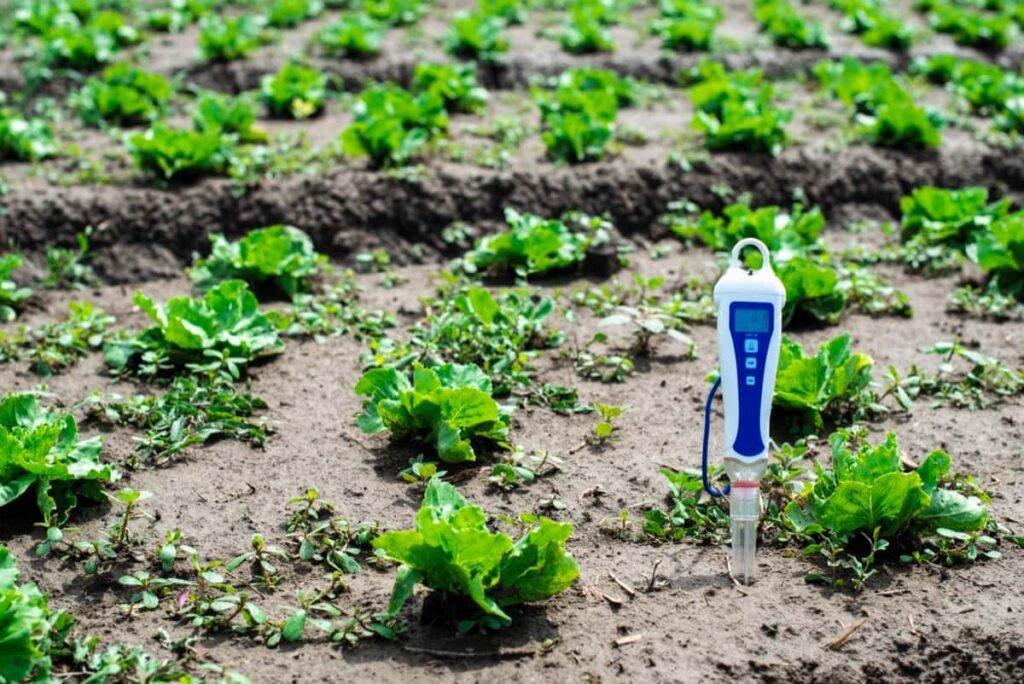
Choosing the Right Plants for Different Soil pH Levels
Leveraging the plant’s soil pH chart’s wisdom, gardeners can make informed decisions in choosing plants that resonate with their garden’s innate soil pH levels. Each plant, whether a vegetable, herb, flower, tree, or shrub, has its unique soil pH formula, dictating its optimal growth conditions. The soil pH chart for vegetables, herbs, trees, and shrubs acts as a gardener’s compass, steering the selection process towards species that will naturally thrive within the existing soil pH conditions.
With this knowledge, selecting plants aligns seamlessly with the inherent soil characteristics, whether they sway towards acidity or alkalinity. For instance, understanding the soil pH requirements for vegetables or the soil pH requirements for flowering plants facilitates the cultivation of a garden where each plant blossoms within its optimal pH range of soil. In essence, choosing the right plants for different soil pH levels, per the guidance of the plant’s soil pH chart, is a strategic step towards cultivating a garden rich in vitality and diversity.
The Role of Soil pH in Nutrient Availability to Plants
Embarking on a gardening journey involves mastering the art and science of soil pH, a critical aspect vividly detailed in the plant’s soil pH chart. This chart unveils the mystery behind the vital role that soil pH plays in the availability of nutrients to plants, acting as a gateway to understanding the soil pH requirements for plants across different categories such as vegetables, herbs, trees, and shrubs. Soil pH acts as a gatekeeper, determining the accessibility of essential nutrients to the plants.
For instance, an optimal pH range of soil ensures that plants can readily absorb the nutrients necessary for their growth and vitality. On this chart, one can find specific guidelines, such as the soil pH requirements for vegetables or the soil pH requirements for flowering plants, each tailored to enhance nutrient absorption and optimize plant health. Understanding and applying the insights from the plant’s soil pH chart allow for a thriving garden where the soil pH and nutrient availability are in harmonious balance, promoting the overall well-being and prosperity of the garden.
Adjusting Soil pH Naturally: Organic Methods and Amendments.
The pursuit of garden excellence often leads to exploring natural and organic ways to adjust soil pH, an endeavor deeply intertwined with the insights offered by the plant’s soil pH chart. This chart is an invaluable guide, rich in information on the soil pH levels for plants, enabling gardeners to align their garden’s pH with the natural needs of their plants, be they vegetables, herbs, trees, or shrubs. Organic methods and amendments stand out as powerful tools in this journey, offering environmentally friendly ways to meet the soil pH requirements for plants.
Natural ingredients like coffee grounds, lemon peels, and wood ash become allies, each possessing unique qualities influencing the soil pH, nudging it closer to the ideal soil pH for plant growth. Utilizing these organic amendments is a harmonious approach, aligning the garden’s essence with the wisdom encapsulated in the plant’s soil pH chart, fostering a space where each plant can thrive in its natural brilliance and vitality. The garden becomes a canvas of health through these natural adjustments, reflecting the balance and harmony of well-adjusted soil pH levels.
The Impact of Soil pH on Water Retention and Drainage
Understanding the subtle intricacies of soil pH is instrumental in mastering the art of gardening, a concept vividly portrayed in the plant’s soil pH chart. This essential tool elucidates the interplay between soil pH and various factors influencing plant growth, such as water retention and drainage.
Soil pH acts as a foundational element, directly impacting how soil manages water, which in turn influences the health and vitality of plants, be it vegetables, herbs, trees, or shrubs. A balanced pH, by the ideal guidelines of the plant’s soil pH chart, fosters a conducive environment where the soil maintains optimal moisture levels, ensuring that plants have access to the necessary water for their growth.
In case you missed it: How to Break Down Clay Soil: Naturally Amending with Gypsum, Manure, Sawdust, Vinegar, Earthworms, and Lime
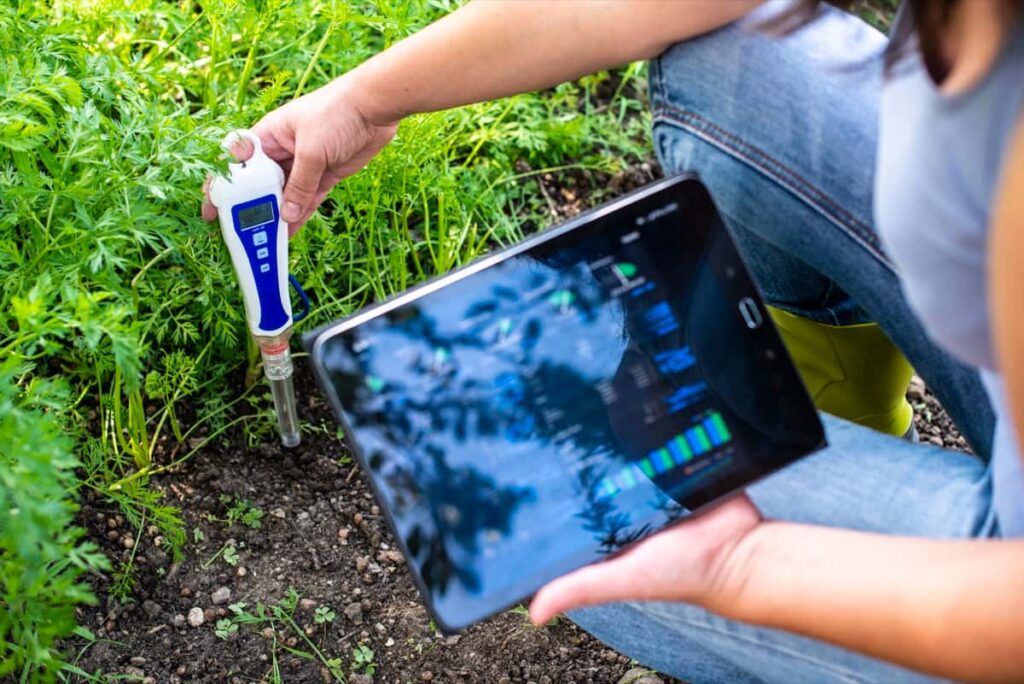
Conversely, an imbalance in soil pH can hinder the soil’s water-retaining capabilities, affecting drainage and potentially leading to waterlogged or overly dry conditions. By adhering to the wisdom of the plant’s soil pH chart and ensuring that the soil pH aligns with the recommended levels, one can cultivate a garden where the soil’s water retention and drainage capabilities are optimized, fostering a nurturing environment for all plants to thrive.
Managing Soil pH in Container Gardening: Tips and Techniques
Container gardening brings unique challenges and opportunities in managing soil pH, a journey deeply enriched by the guidance offered by the plant’s soil pH chart. Container gardening, while offering flexibility and convenience, requires meticulous attention to the soil’s pH levels to ensure the thriving of plants, whether they be herbs, vegetables, flowers, trees, or shrubs. The confined environment of a container necessitates precise adjustments to meet the soil pH requirements for plants, ensuring that each plant has the optimal pH range of soil to flourish.
Utilizing the plant’s soil pH chart, gardeners can tailor the soil conditions within each container, applying specific adjustments, amendments, and care to meet the unique needs of each plant type. Essential strategies include carefully selecting soil, regular pH testing, and the application of natural amendments to maintain a balanced pH. Armed with the insights and guidelines from the plant’s soil pH chart, managing soil pH in container gardening becomes more navigable and rewarding, ensuring that each container blossoms with the vibrant energy and beauty of healthy, thriving plants.
Vegetable Plants Optimal Soil pH Chart
| Vegetable | Optimal Soil pH |
| Asparagus | 6.0 – 8.0 |
| Beans | 6.0 – 7.5 |
| Broccoli | 6.0 – 7.0 |
| Cabbage | 6.0 – 7.5 |
| Carrots | 5.5 – 7.0 |
| Cauliflower | 5.5 – 7.5 |
| Corn | 5.5 – 7.0 |
| Cucumbers | 5.5 – 7.0 |
| Garlic | 5.5 – 7.5 |
| Kale | 6.0 – 7.5 |
| Lettuce | 6.0 – 7.0 |
| Onions | 6.0 – 7.0 |
| Peas | 6.0 – 7.5 |
| Peppers | 5.5 – 7.0 |
| Potatoes | 4.8 – 5.5 |
| Radishes | 6.0 – 7.0 |
| Spinach | 6.0 – 7.5 |
| Tomatoes | 6.0 – 6.8 |
| Zucchini | 6.0 – 7.5 |
In case you missed it: 22 Agricultural Apps for Smart Farming Solutions: Help with Farm Management, Soil, and Crop Yield
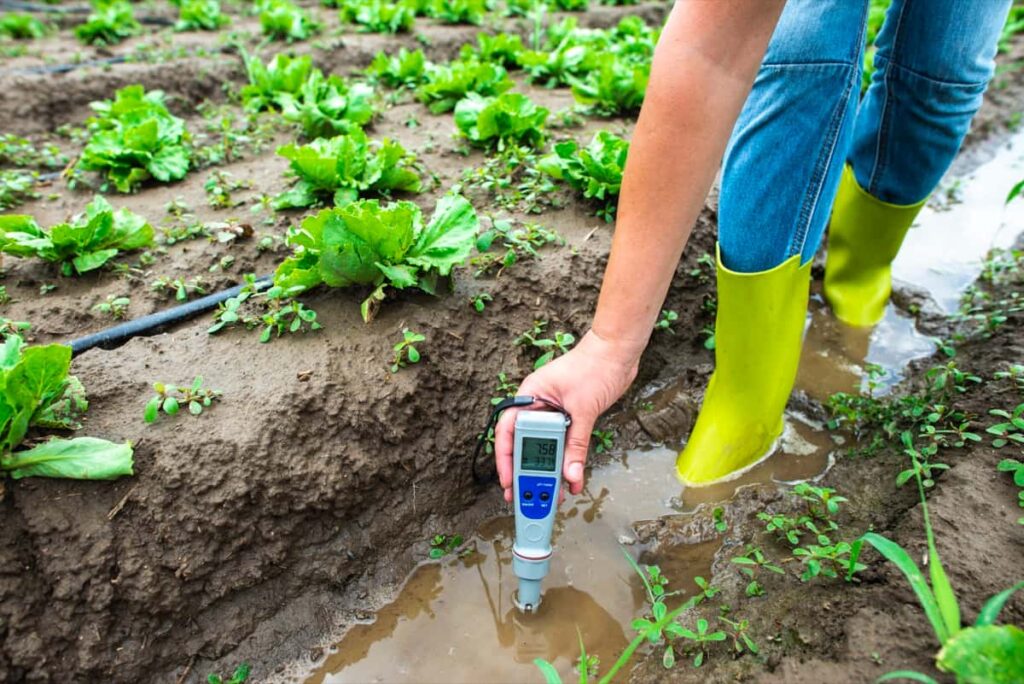
Flowering Plants Optimal Soil pH Chart
| Flowering Plant | Optimal Soil pH |
| Azaleas | 4.5 – 6.0 |
| Begonias | 5.5 – 7.0 |
| Calendulas | 6.0 – 7.5 |
| Daffodils | 6.0 – 6.5 |
| Dahlias | 6.5 – 7.5 |
| Geraniums | 6.0 – 7.0 |
| Hibiscus | 6.0 – 7.5 |
| Hydrangeas | 5.0 – 6.5 |
| Lavender | 6.5 – 7.5 |
| Marigolds | 5.5 – 7.0 |
| Pansies | 5.5 – 6.5 |
| Petunias | 6.0 – 7.5 |
| Roses | 6.0 – 6.5 |
| Snapdragons | 6.0 – 7.5 |
| Sunflowers | 6.0 – 7.5 |
| Tulips | 6.0 – 7.0 |
| Zinnias | 5.5 – 7.5 |
Trees and Shrubs Optimal Soil pH Chart
| Trees and Shrubs | Optimal Soil pH |
| Apple Tree | 6.0 – 7.0 |
| Azalea | 4.5 – 6.0 |
| Blue Spruce | 5.5 – 7.0 |
| Cedar | 6.0 – 7.5 |
| Cherry Tree | 6.0 – 7.5 |
| Dogwood | 5.5 – 6.0 |
| Fig Tree | 6.0 – 6.5 |
| Holly | 5.0 – 6.0 |
| Hydrangea (Shrub) | 5.0 – 6.5 |
| Maple Tree | 6.0 – 7.5 |
| Oak Tree | 5.5 – 6.5 |
| Pine | 4.5 – 6.0 |
| Rhododendron | 4.5 – 6.0 |
| Willow | 6.0 – 8.0 |
| Birch | 5.0 – 6.0 |
| Magnolia | 5.0 – 6.0 |
| Juniper | 5.5 – 7.0 |
| Redbud | 5.5 – 6.5 |
| Spruce | 5.5 – 7.5 |
| Hemlock | 5.0 – 6.0 |
| Poplar | 6.0 – 8.0 |
| Fir | 5.0 – 6.0 |
| Elm | 5.5 – 7.5 |
| Cypress | 5.0 – 6.0 |
| Sycamore | 5.0 – 7.5 |
| Beech | 5.0 – 6.0 |
| Ash | 6.0 – 7.5 |
| Pineapple Guava (Shrub) | 5.5 – 7.0 |
| Boxwood (Shrub) | 6.0 – 7.5 |
| Yew | 5.5 – 6.5 |
In case you missed it: How to Fix Sulfur Deficiency in Plants/Soil: Preventing Naturally, Organically, and Chemically
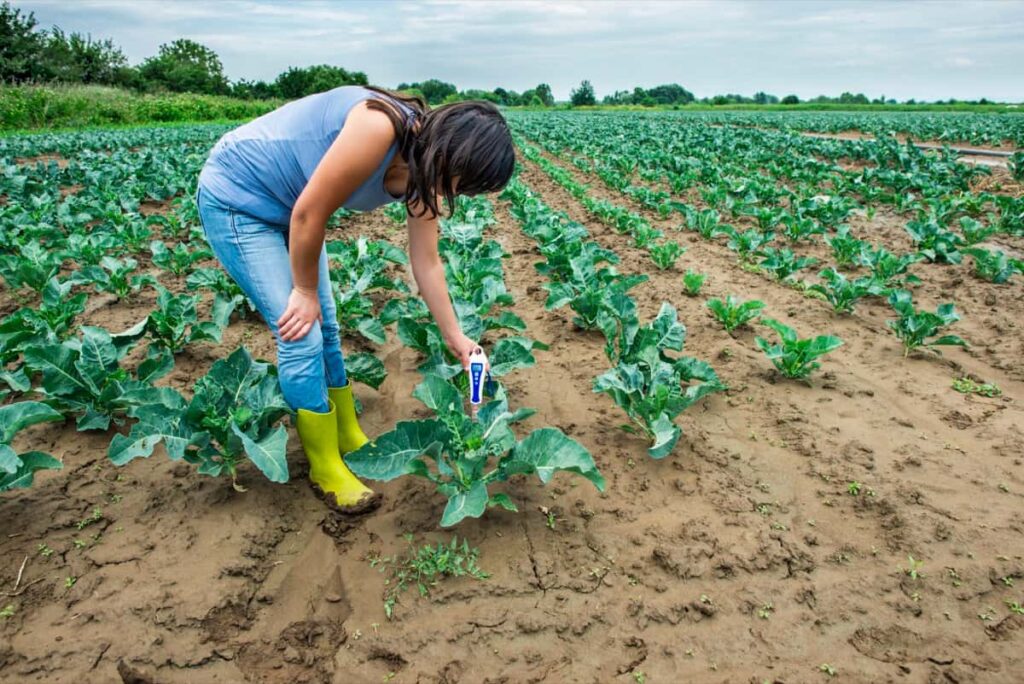
Herbs Optimal Soil pH Chart
| Herbs | Optimal Soil pH |
| Basil | 6.0 – 7.5 |
| Cilantro | 6.0 – 7.5 |
| Dill | 5.5 – 7.5 |
| Thyme | 6.0 – 7.0 |
| Oregano | 6.0 – 8.0 |
| Parsley | 5.0 – 7.0 |
| Rosemary | 5.0 – 6.0 |
| Mint | 6.0 – 7.5 |
| Chives | 6.0 – 7.0 |
| Sage | 5.5 – 6.5 |
| Lavender | 6.5 – 7.5 |
| Lemon Balm | 6.0 – 7.5 |
| Tarragon | 6.0 – 7.5 |
| Marjoram | 6.0 – 8.0 |
| Fennel | 5.5 – 6.8 |
| Chamomile | 5.5 – 7.5 |
| Borage | 6.0 – 7.0 |
| Coriander | 6.0 – 7.5 |
| Catnip | 6.0 – 7.5 |
| Echinacea | 5.5 – 6.0 |
| Peppermint | 6.0 – 7.5 |
| Spearmint | 5.5 – 7.5 |
| Lemongrass | 5.0 – 7.5 |
| Bay Laurel | 6.0 – 7.5 |
| Curry Plant | 6.0 – 7.5 |
| Feverfew | 6.0 – 6.7 |
| Horseradish | 6.0 – 7.0 |
| Stevia | 6.0 – 7.5 |
| Comfrey | 6.0 – 7.0 |
| Arnica | 5.5 – 6.0 |
Conclusion
Understanding and managing the soil pH levels specific to each plant type is crucial for their growth, health, and productivity. Utilizing the provided soil pH charts as guides will enable gardeners to create optimal growing conditions, ensuring that plants, whether vegetables, flowers, trees, or herbs, thrive and flourish in their respective environments.
- Crops Grown in Summer Season: Best Choices for Summer Gardening
- Organic Pest Control for Tomato Farming
- How to Maximize Sheep Farming Profit
- Broccoli Varieties: Choosing the Right Cultivars for Your Farm
- How to Raise Pigs in Your Own Backyard: A Comprehensive Guide
- Budget Friendly Sheep Shed Ideas: Cheap and Low-Cost Tips
- How Much Do Cattle Farmers Make: Revenue Streams in Cattle Farming
- Management Pests and Diseases in Your Cotton Field
- Sheep Farming Business Plan for Beginners
- Aquaponic Farming at Home: A Step-By-Step Guide
- Profitable Village Farming Business Ideas in 2024
- High-Yield Aquaculture: Fast-Growing Fish for Farming
- Effective Fish Pond Construction Techniques for Beginners
- Irrigation and Water Management in Pineapple Farming
- Blossom to Harvest: Mastering Flowering and Pollination in Papaya Farming
- Pig Fattening Essentials: From Selection to Sale for Beginners
- Raising Wagyu Cattle: A Complete Guide for Premium Beef Production
- Soil Types and Their Water Holding Capacity
- Optimizing Irrigation Schedules for Coconut Groves for Enhanced Yield
- Espresso Your Garden: Coffee Grounds for Healthier Acid-Loving Plants
- The Best Soil Mix for Snake Plants: How to Mix Your Own Snake Plant Soil
- Green Thumb Success: Expert Tips for Cultivating Greenhouse Beans All Year Round
- Bloom All Year Round: The Ultimate Guide to Indoor Hyacinth Care
- Eco-Friendly Gardening: How to Make Liquid Fertilizer from Kitchen Waste
- Ultimate Guide to Grow Anise in Pots: Explore Seed Propagation to Harvesting
- Guide to Raising Chester White Pigs: Discover Breed Facts to Growth Management
- Mastering the Elegance: The Ultimate Guide to Weeping Cherry Tree Care, Planting, and Maintenance
- Ultimate Guide to Planting Garlic in Grow Bags: Growing Strategies for Beginners
- How to Fix Spider Plant Leaf-Related Problems: Natural and Organic Remedies
- 10 Reasons Why Your Tulsi Plant is Shedding Leaves: Home Remedies and Solutions
- Optimizing Growth and Yield: The Advantages of Palm Bunch Ash Fertilizer
- Utilizing Neem Oil Extract as a Natural Pesticide for Hydrangea
- From Soil to Harvest: Various Ways in Which Farmers Can Use AI Tools
- Steps to Encourage and Induce Citrus Flowers: A Comprehensive Guide
- How to Fix Snake Plant Leaf-Related Issues: Natural and Organic Remedies
- Transform Your Garden into a Fragrant Oasis with Raat Ki Rani (Night Blooming Jasmine)
